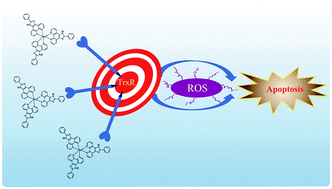Ruthenium polypyridyl complexes as inducer of ROS-mediated apoptosis in cancer cells by targeting thioredoxin reductase†
Abstract
TrxR is an NADPH-dependent selenoenzyme upregulated in a number of cancers. It plays a pivotal role in cancer progression and represents an increasingly attractive target for anticancer drugs. The limitations of cisplatin in cancer treatment have motivated the extensive investigation to other metal complexes, especially ruthenium (Ru) complexes. In this study, we present the in vitro biological evaluation of four Ru(II) polypridyl complexes with diimine ligands, namely, [Ru(bpy)3]2+ (1), [Ru(phen)3]2+ (2), [Ru(ip)3]2+ (3), [Ru(pip)3]2+ (4) (bpy = 2,2′-bipyridine, phen = 1,10-phenanthroline, ip = imidazole[4,5-f][1,10]phenanthroline, pip = 2-phenylimidazo[4,5-f][1,10]phenanthroline), and demonstrate that they exhibit antiproliferative activities against A375 human melanoma cells through inhibition of TrxR. As the planarity of the structure increases, their TrxR-inhibitory effects and in vitro anticancer activities were enhanced. Among them, complex 4 exhibited higher antiproliferative activity than cisplatin, and the TrxR-inhibitory potency of 4 was more effective than auranofin, a positive TrxR inhibitor. Complex 4 suppressed the cancer cell growth through induction of apoptosis as evidenced by accumulation of sub-G1 cell population, DNA fragmentation and nuclear condensation. Moreover, complex 4 was able to localize in mitochondria and therein induced ROS-dependent apoptosis by inhibition of TrxR activity. Activation of MAPKs, AKT, DNA damage-mediated p53 phosphorylation and inhibition of VEGFR signaling were also triggered in cells exposed to complex 4. On the basis of this evidence, we suggest that Ru polypyridyl complexes could be developed as TrxR-targeted agents that demonstrate application potentials for treatment of cancers.


 Please wait while we load your content...
Please wait while we load your content...